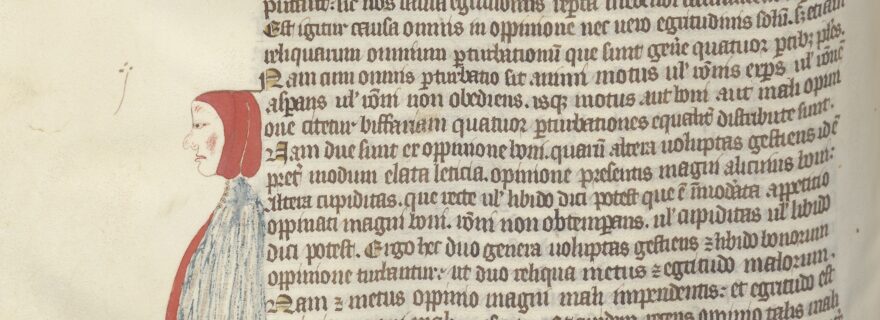‘Red Riding Hood’ and the wolf: Marginal drawings in a collection of Cicero’s works
Leiden, Universiteitsbibliotheek, PER F 25, a fifteenth-century collection of works by Cicero, contains a number of interesting marginal drawings, but how, if at all, do they relate to its text?
Once upon a time, as all good tales must start, I turned a page of a manuscript in the quiet of Leiden University Library and found myself face-to-face with Red Riding Hood [Fig. 1]. At least, if not the star of the well-known tale herself, her medieval doppelganger: clad in a red hooded dress, with rosy cheeks, a blue cloak securely buttoned to her neck, and wearing coordinating red socks and tiny pointed shoes. The detail of the drawing surprised me; her cloak was shaded in strokes of different colours to convey its folds, while a disproportionally large nose dominated her face, jutting out over her thin red lips.
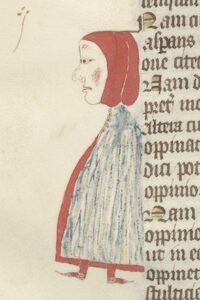
However, just as Red Riding Hood was surprised to find a wolf in her grandmother’s bed, so too I was surprised to find such a drawing in this particular manuscript. Leiden, Universiteitsbibliotheek PER F 25, is not a collection of fairy tales, but of works by the Roman writer and statesman Cicero (106-46 BCE). Why was such a characterful drawing standing cheek by jowl to one of his philosophical texts, the Tusculan Disputations (Tusculanae Disputationes)? This question has led to me to a detailed exploration of the contents and history of PER F 25, a manuscript which, although not full of fairy tales, certainly has its own story to tell.
Dating the text:
This collection of Cicero’s works is written in a gothic script (littera textualis), and was copied in the north of France, potentially by a scribe associated with Pierre d’Ailly (1350-1420), Bishop of Cambrai, as argued by Gilbert Ouy (Rouse and Rouse, 1992, p. 72). The manuscript also appears to have connections with Brittany, as it contains a number of coats of arms of various Breton families (ff. 115v, 121v, 178v, 202v, 205r, 223r, 237v, 296v), at least some of which were added by the scribe, or by the decorator of the manuscript. As David Hunt and others have argued, the manuscript was copied no earlier than 1409, as it also contains a coat of arms (f. 229v) of Pedro de Luna, Pope Benedict XIII (ca. 1328-1423), who was relegated to anti-pope at the Council of Pisa in 1409 (Hunt, 1998, p. 57). The coat of arms refers to him as hereticus, a heretic, an appellation that would not have been appropriate prior to this date. In fact, Hunt, following Peter Lebrecht Schmidt, ventures that the manuscript was probably copied even later, as it also contains a short text which refers to Charles VI as the former [‘quondam’] king of France; Charles died in 1422.
Responding to the text:
But to return to ‘Red Riding Hood’; what was she doing in the margins of these texts of Cicero? It was, of course, not unusual for medieval scribes to add drawings to their texts. Doodles, cartoons, small flourishes: all of these served to entertain the reader, to draw their eye to particular passages, and, sometimes, to help them navigate their texts. This particular sketch is found alongside Cicero’s Tusculan Disputations III.XI.24-5 (f. 151v), which discusses the nature of pleasure and lust, fear and grief, all of which can be regarded as disorders of the mind. While the passage does not restrict itself to physical lust, might this drawing of a woman be intended to remind the, most likely a clerical, reader of the text of forbidden (sexual) pleasures? The evidence is inconclusive in this case, but if we look at other examples of marginal drawings from the manuscript we’ll see that, on occasion at least, this artist seems to be in conscious conversation with the texts of the manuscript.
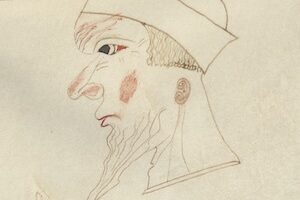
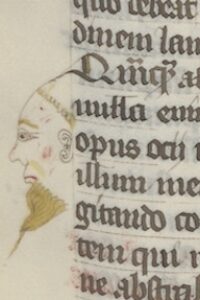
For example, Book III of Cicero’s On Duties [De officiis], another text included within this manuscript, opens with a description of the famous Roman general, Scipio Africanus, who claimed to be ‘never less at leisure than when he was at leisure, nor less alone than when he was alone’ (III.1, trans. Atkins (2003), p. 101). Close to the opening of this part of the text, alongside another mention of Scipio (f. 35r), the scribe drew a face in the margin [Fig. 2]. Wearing a hat and with a pointed beard, the portrayal serves to draw attention to the example. Similarly, on f. 140v [Fig. 3], where Cicero refers to Hieronymous of Rhodes (Tusculan Disputations, II.VI.15), a man’s face with a pointed beard and hat has been added to the lower margin of the page, highlighting the opinion of this philosopher. In these drawings the use of exaggerated, even exotic, clothing and features serves to summon these figures from the past into the medieval present of the reader.
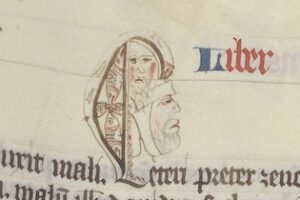
Facing the reader
Sometimes the illustrator used faces in the manuscript in a generic manner: for example, simply to ornament ascenders on letters which reached into the upper margin. In other cases, however, faces which cannot be associated with any particular person are added to draw attention to different philosophical points of view, or to differentiate between a variety of examples. This is the case on f. 141r [Fig. 4] where the ‘c’ of the word ‘ceteri’, meaning ‘the others’, or in this case ‘the rest [of the philosophers]’ (Tusculan Disputations, II.VI.15), has been ornamented with two small faces. Here in addition to taking advantage of the space afforded by the upper margin to expand and ornament the letter, the scribe visually evokes the philosophers with whom Cicero is in argument.
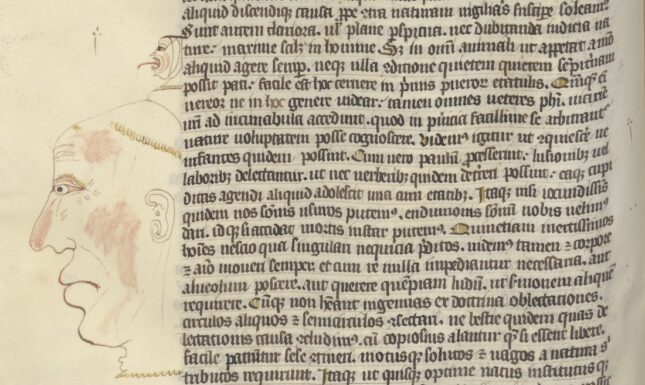
One more example will suffice to show how the scribe humorously worked illustrations into to the margins of the text. In On the ends of good and evil [De finibus bonorum et malorum] V.XX.55-56, Cicero discusses how people crave constant activity, a trait that manifests itself in children as physical exuberance and in ‘men of ability’ (trans. Rackham (1914), p. 257) as a desire to engage in intellectual activity. Adjacent to this passage (f. 109v, Fig. 5), the scribe has added two faces: a small one with their tongue stuck out, presumably representing the exuberant child, and a larger face, tonsured like a monk, presumably representing the adult man, who is able to channel their desire for activity in a productive manner. Here the drawings make explicit the implicit contrasts drawn in Cicero’s text.
The wicked wolf?
Back to ‘Red Riding Hood’… while not all of the penwork illustrations in the volume correspond directly to the text and are best regarded as generic decoration, some clearly do engage directly with its contents. By carrying out additional research on this manuscript, I hope to investigate which passages attracted such attention, and so determine whether there are notable patterns in its illustration programme. This route of study may also provide valuable information about the context of production and use of PER F 25.
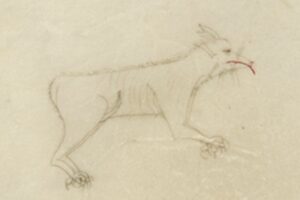
To conclude (albeit at the risk of pushing the comparison of my drawing to the victim of Grimm’s tale a little too far!) where we find ‘Red Riding Hood’, we must also seek the wolf… We find her sketched in the bottom of f. 234v [Fig. 6], where Cicero refers to the ‘Martian beast, the nurse of Roman dominion’ (On divination = De divinatione, I.XII.20, trans. King (1927), p. 247), that is, to the she-wolf who suckled Romulus and Remus. The wolf has sharp claws, with a long red tongue and red eyes. Her bushy tail is tucked bashfully between her legs, but the implicit message is clear – pay attention, reader! This researcher has been warned…
Further reading:
- Cicero, De finibus (On Ends), trans. H. Rackham (LCL 40, Cambridge, MA 1914)
- Cicero, De divinatione (On Divination), trans. W. A. Falconer (LCL 154, Cambridge, MA, 1923)
- Cicero, Tusculanae disputationes (Tusculan Disputations, trans. J. E. King (LCL 141, Cambridge, MA, 1927)
- Cicero, On Duties, ed. M. T. Griffin and E. M. Atkins (Cambridge, 2003)
- Gumbert, J. P. ‘Cicerones Leidenses’, in C. A. Chavannes-Mazel and M. M. Smith (eds), Medieval Manuscripts of the Latin Classics: Production and Use (Leiden, 1996), pp. 209-44.
- Hunt, D. J., A Textual History of Cicero’s Academici Libri (Leiden, 1998).
- Rouse M. A. and Rouse, R. H., ‘The Medieval Circulation of Cicero’s “Posterior Academics” and the De finibus bonorum et malorum’, in Authentic Witnesses: Approaches to Medieval Texts and Manuscripts (Notre Dame, IN, 1992), pp. 61-98.
- Schmidt, P. L., Die Überlieferung von Ciceros Schrift: de legibus in Mittelalter und Renaissance (Munich, 1974)
© Irene O'Daly and Leiden Medievalists Blog, 2021. Unauthorised use and/or duplication of this material without express and written permission from this site’s author and/or owner is strictly prohibited. Excerpts and links may be used, provided that full and clear credit is given to Irene O'Daly and Leiden Medievalists Blog with appropriate and specific direction to the original content.


